1993 BUICK REGAL lights
[x] Cancel search: lightsPage 95 of 308
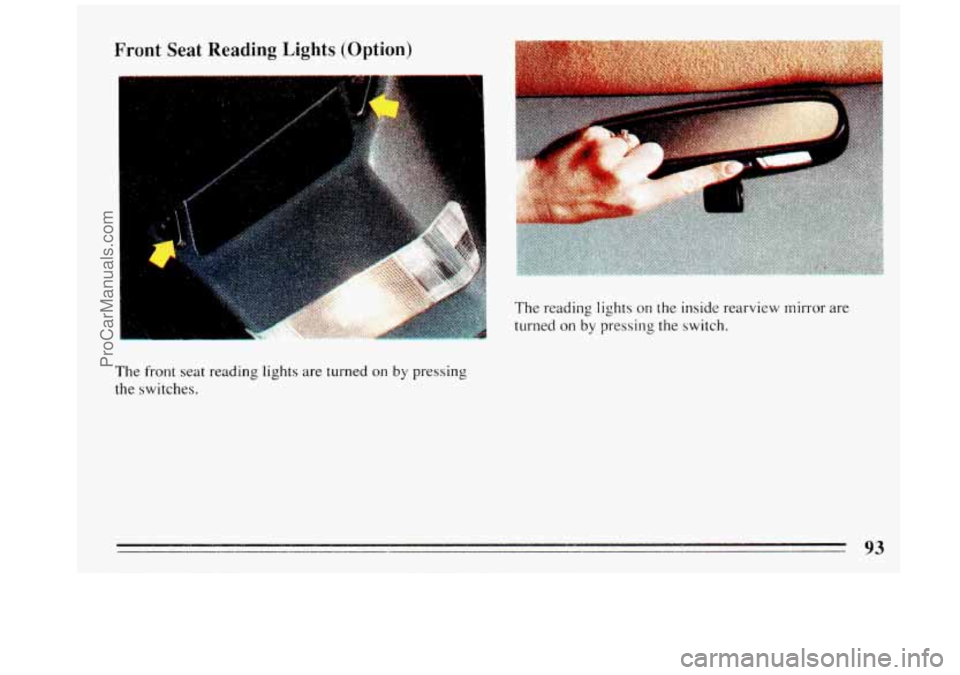
Front Seat Reading Lights (Option)
The front seat reading lights are turned on by pressing
the switches. The
reading lights
on the inside rearview mirror are
turned on
by pressing the switch.
93
ProCarManuals.com
Page 96 of 308

Courtesy Lights
When any door is opened, several lights turn on. They
make it easy for you to enter and leave the car. The
courtesy lights
go off when the doors are closed.
The interior courtesy lights can be turned on by sliding
the light switch to INT or by sliding the switch to
OFF.
You can also change the brightness of the instrument
panel lights by sliding the switch between
OFF and
BRT.
The instrument panel lights
will come on when a door is
opened and closed. The instrument panel lights
will
automatically go off after approximate1.y 30 seconds,
unless the headlights or parking lights have been turned
on.
Mirrors
Inside Mirror
When you are sitting in a comfortable driving position,
adjust the mirror
so you can see clearly behind your car.
The day-night adjustment allows you to adjust the
mirror to avoid glare
from the lights behind you.
94
ProCarManuals.com
Page 102 of 308
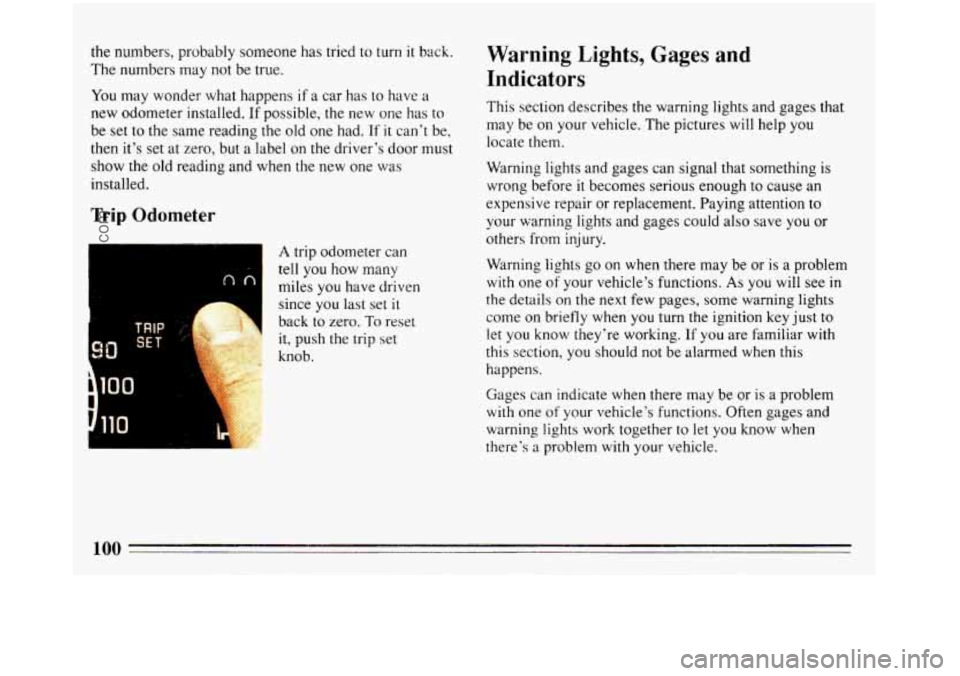
the numbers, probably someone has tried to turn it back.
The numbers may not be true.
You may wonder what happens if a car has to have a
new odometer installed. If possible, the new one has to
be set to the same reading the old one had. If it can’t be,
then it’s set at zero, but
a label on the driver’s door must
show the old reading and when the new one was
installed.
Trip Odometer
TRIP
SET 90
A trip odometer can
tell
you how many
miles you have driven
since you last set
it
back to zero. To reset
it, push the trip set
knob.
Warning Lights, Gages and
Indicators
This section describes the warning lights and gages that
may be on your vehicle. The pictures will help you
locate them.
Wdrning lights and gages can signal that something
is
wrong before it becomes serious enough to cause an
expensive re,pair or replacement. Paying attention to
your warning lights and gages could also save you or
others from injury.
Warning lights go on when there may be or
is a problem
with one of your vehicle’s functions. As you will see in
the details on the next few pages, some warning lights
come on briefly when you turn
the ignition key just to
let you know they’re working.
If you are familiar with
this section, you should not be alarmed when this
happens.
Gages
can indicate when there may be or is a problem
with one of your vehicle’s functions. Often gages and
warning lights work together
to let you know when
there’s a problem with your vehicle.
100
ProCarManuals.com
Page 103 of 308

When one of the warning lights comes on and stays on
when you are driving,
or when one of the gages shows
there may be a problem, check the section that tells
you
what to do about it. Please follow the manual’s advice.
Waiting to do repairs can be costly
-- and even
dangerous.
So please get to know your warning lights
and gages. They’re a big help.
Fuel Gage
UNLEADEL,
FUEL
ONLY
Your fuel gage shows about
how much
fuel is in your
tank. It works
only when
the engine is on. When the
indicator nears
“E,” you
still have a little fuel left.
You need to get more right
away.
Here are
four concerns some owners have had about the
fuel gage. All these situations are normal and indicate
nothing wrong with the
fuel gage.
8 At the gas station, the gas pump shuts off before the
gage reads
“F”.
indicated. For example, the gage indicated 1/2 full,
but
it took more -- or less -- than half of the tank’s
capacity
to fill it.
e It takes more (or less) gas to fill up than the gage
e The gage moves a little when you turn a corner,
speed
up, or stop your vehicle.
When
you turn the engine off, the gage doesn’t go all
the
way back to “E”.
Low Fuel Light
LOW
FUEL
When your fuel gage reads
in the red band, this light
will
go on. You should get
more fuel as soon
as you
can.
101
ProCarManuals.com
Page 135 of 308
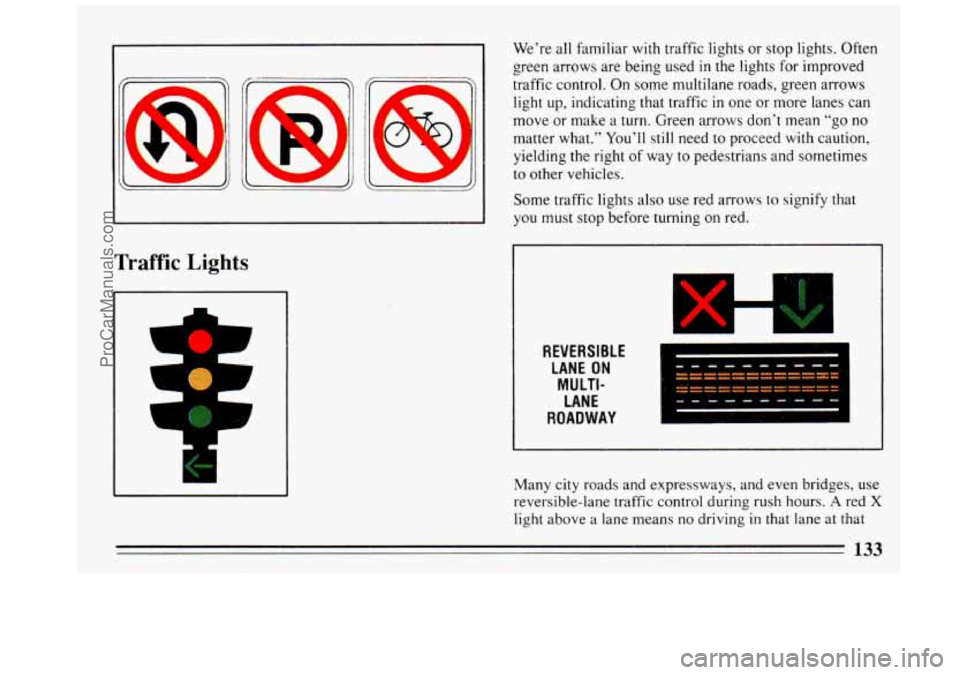
Traffic Lights
A
We’re all familiar with traffic lights or stop lights. Often
green arrows are being used in the lights for improved
traffic control.
On some multilane roads, green arrows
light up, indicating that traffic in one or more lanes can
move or make a turn. Green arrows don’t mean
“go no
matter what.” You’ll still need to proceed with caution,
yielding the right of way to pedestrians and sometimes
to other vehicles.
Some traffic lights also use red arrows to signify that
you must stop before turning
on red.
REVERSIBLE
LANE ON
LANE
ROADWAY
NIULTI-
Many city roads and expressways, and even bridges, use
reversible-lane traffic control during rush hours.
A red X
light above a lane means no driving in that lane at that
133
ProCarManuals.com
Page 136 of 308
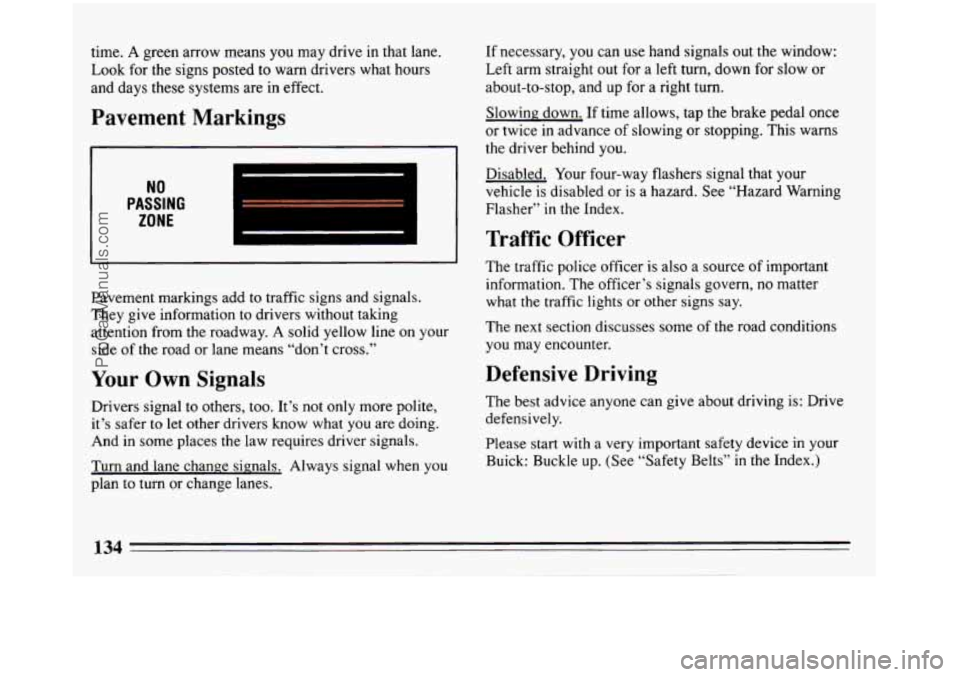
time. A green arrow means you may drive in that lane.
Look for the signs posted to warn drivers what hours
and days these systems are in
effect.
Pavement Markings
NO
PASSING
ZONE
Pavement markings add to traffic signs and signals.
They give information to drivers without taking
attention from the roadway.
A solid yellow line on your
side of the road or lane means “don’t cross.”
Your Own Signals
Drivers signal to others, too. It’s not only more polite,
it’s safer
to let other drivers know what you are doing.
And in some places the law requires driver signals.
Turn and lane change signals. Always signal when
you
plan to turn or change lanes. If
necessary,
you can use hand signals out the window:
Left arm straight out for a left turn, down for slow or
about-to-stop, and up for
a right turn.
Slowing down. If time allows, tap the brake pedal once
or twice in advance of slowing or stopping. This warns
the driver behind you.
Disabled. Your four-way flashers signal that your
vehicle is disabled or
is a hazard. See “Hazard Warning
Flasher”
in the Index.
Traffic Officer
The traffic police officer is also a source of important
information. The officer’s signals govern,
no matter
what
the traffic lights or other signs say.
The next section discusses some of the road conditions
you may encounter.
Defensive Driving
The best advice anyone can give about driving is: Drive
defensively.
Please start with a very important safety device in your
Buick: Buckle up. (See “Safety Belts” in
the Index.)
134
-
ProCarManuals.com
Page 147 of 308

What should you do if this ever happens? Let up on the
brake or accelerator pedal, steer the vehicle the way you
want it to
go, and slow down.
Speed limit signs near curves warn that
you should
adjust your speed. Of course, the posted speeds are
based on good weather and road conditions. Under less
favorable conditions you’ll want to
go slower.
If you need to reduce your speed as
you approach a
curve, do it before
you enter the curve, while your front
wheels are straight ahead.
Try to adjust your speed
so you can “drive” through the
curve. Maintain a reasonable, steady speed. Wait to
accelerate until you are out
of the curve, and then
accelerate gently
into the straightaway.
When you drive into a curve at night, it’s harder to see
the road ahead of you because it bends away from the
straight beams
of your lights. This is one good reason to
drive slower.
Steering in Emergencies
There are times when steering can be more effective
than braking. For example,
you come over a hill and
find a truck stopped in your lane, or a car suddenly pulls
out from nowhere, or a child darts out from between
parked cars and stops right in front
of you. You can
avoid these problems by braking
-- if you can stop in
time. But sometimes
you can’t; there isn’t room. That’s
the time for evasive action
-- steering around the
problem.
Your Buick can perform very well in emergencies like
these. First apply your brakes
-- but, unless you have
anti-lock, not enough to lock your wheels. It is better to
remove as much speed
as you can from a possible
collision. Then steer around the problem, to the left or
right depending on the space available.
An emergency like this requires close attention and a
quick decision. If you are holding the steering wheel at
the recommended
9 and 3 o’clock positions, you can
turn it a
full 180 degrees very quickly without removing
either hand.
Rut you have to act fast, steer quickly, and
just as quickly straighten
the wheel once you have
avoided the object. You must then be prepared
to steer
back to your original lane and then brake to a controlled
stop.
Depending on your speed, this can be rather violent for
an unprepared driver. This
is one of the reasons driving
1 AC
ProCarManuals.com
Page 150 of 308
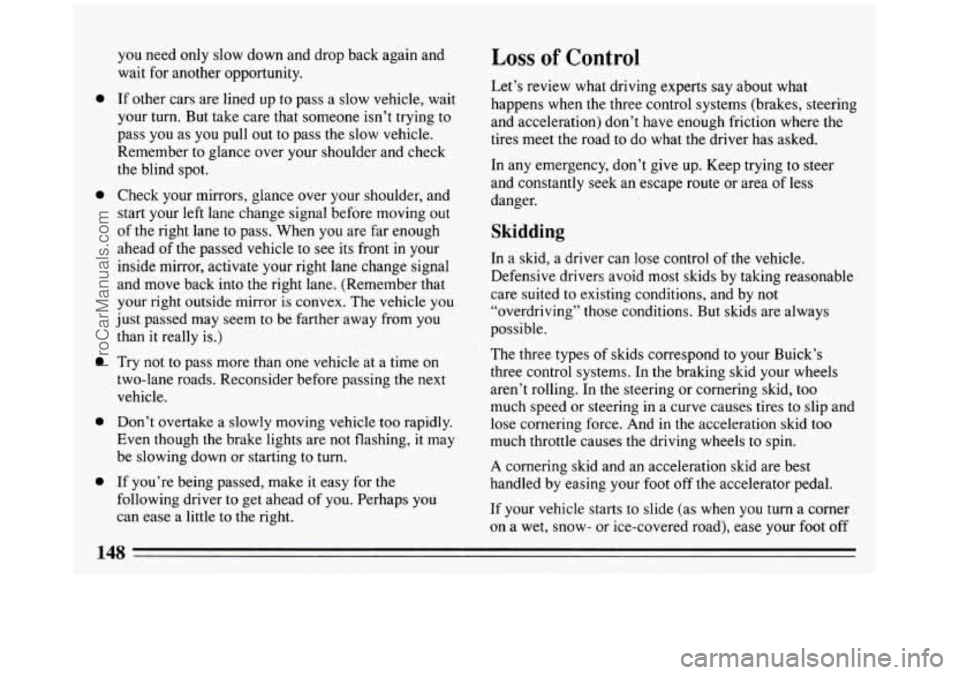
0
0
0
0
0
you need only slow down and drop back again and
wait
for another opportunity.
If other cars are lined up to pass a slow vehicle, wait
your turn. But take care that someone isn’t trying to
pass you as you pull out to pass the slow vehicle.
Remember to glance over your shoulder and check
the blind spot.
Check your mirrors, glance over your shoulder, and
start your left lane change signal before moving out
of the right lane to pass. When you are far enough
ahead of the passed vehicle to see its front
in your
inside mirror, activate your right lane change signal
and move back into the right lane. (Remember that
your right outside
mirror is convex. The vehicle you
just passed may seem to be farther away from
you
than it really is.)
Try not to pass more than one vehicle at a time
on
two-lane roads. Reconsider before passing the next
vehicle.
Don’t overtake a slowly moving vehicle too rapidly.
Even though
the brake lights are not flashing, it may
be slowing down or starting to turn.
If you’re being passed, make it easy for the
following driver to get ahead of you. Perhaps
you
can ease a little to the right.
Loss of Control
Let’s review what driving experts say about what
happens when the three control systems (brakes, steering
and acceleration) don’t have enough friction where the
tires meet the road to do what the driver has asked.
In any emergency, don’t give up. Keep trying
to steer
and constantly seek an escape route or area of less
danger.
Skidding
In a skid, a driver can lose control of the vehicle.
Defensive drivers avoid most skids by taking reasonable
care suited to existing conditions, and by not
“overdriving” those conditions. But skids are always
possible.
The three types
of skids correspond to your Buick’s
three control system.s. In
the braking skid your wheels
aren’t rolling. In the steering or cornering skid,
too
much speed or steeri.ng in a curve causes tires to slip and
lose cornering force.
And in the acceleration skid too
much throttle causes the driving wheels to spin.
A cornering skid and an acceleration skid are best
handied by easing your foot off the accelerator pedal.
If your vehicle starts
to slide (as when you turn a corner
on a wet, snow- or ice-covered road), ease your
foot off
148
ProCarManuals.com